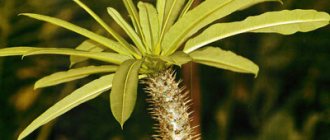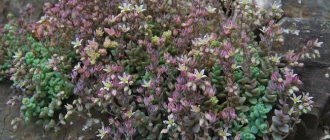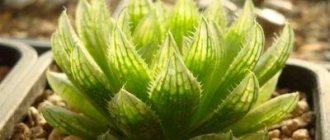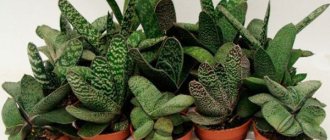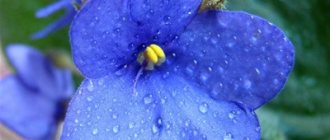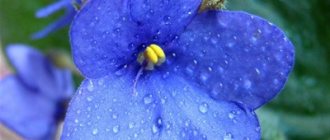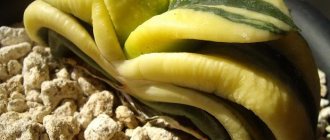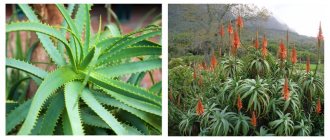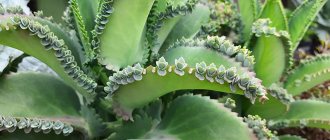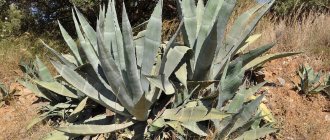The name of the genus alludes to the swelling of the perianth tube: lat. gastrum - “bellied vessel”.
Flowers 1-3 cm long are located on an apical peduncle 30-50 cm long, creamy pink with a smooth color transition. The base of the flower is swollen.
Gasteria leaves are initially arranged in two rows and form a dense fan. With age, they begin to grow in a spiral.
The leaves are fleshy, very hard, tongue-shaped, sometimes pointed at the ends. The surface is smooth, shiny or rough, often covered with warts or spots.
Photo @myntsri, Instagram
The structure of gasteria
(to view information, hover over the markers)
Description and origin of gasteria
The genus Gasteria contains 26 species of gasteria. On their basis, about 100 hybrids have been bred through selection. The ancestral home is South Africa. These are succulent herbaceous perennials. In almost all varieties, the leaves grow in a spiral. Over time, a rosette with leathery leaves up to 10 cm long is formed. The total height of the bush rarely exceeds 20 cm.
In the wild, it quickly reproduces by daughter rosettes. As a result of fairly rapid spread, it forms extensive clumps. Blooming clumps are a picturesque sight. Numerous inflorescences of delicate shades are attached to a single peduncle. The bell-shaped buds open at dawn and close towards sunset.
General information
The Gasteria flower is native to South Africa, so it is accustomed to heat and little water. The plant is able to store water in its leaves. This perennial with thick leaves is usually popularly called “lawyer’s tongue.”
The leaves are colored differently depending on the species. The color of the leaves is both green and light tones, and dark tones; the plant can be spotted.
There is only one drawing for everyone. About 80 species have been recorded, but only a few have been domesticated.
How to grow gasteria?
Keeping it at home will not cause much trouble. It is enough to provide comfortable conditions and follow the rules of care.
Lighting
You can keep a flower pot with a succulent on any windowsill. However, you should know that northern windows do not contribute to the appearance of ovaries. The ideal directions for abundant flowering are western and/or eastern.
What to do if the room does not have access to the west or east? Ultraviolet deficiency can be compensated with the help of a phytolamp. At the same time, experts insist: the lamp power must be at least 6500K. Lower values are not able to stimulate the release of the peduncle.
Irrigation
The South African is not prone to excessive water consumption. The main thing in caring for gasteria is to monitor the condition of the soil. Once the soil is completely dry, water the flower generously. Remember, excess moisture is an enemy that can quickly destroy roots. How to determine the condition of the soil? Watering time is approximately 3 days after the top layer of soil has dried.
In winter, the amount of watering should be reduced to the required minimum. As soon as the central heating comes on, additional humidification will be required. A household humidifier will help with this. The simplest alternative is a damp layer of pebbles at the bottom of the pot.
Air temperature
Temperature indicators do not play a special role in the life of an adult specimen. But kids will need special conditions. Optimal limits: in summer – within +27°, in winter – from +10° to +15°.
Fertilizers
Of course, the best and easiest way is to use specialized industrial fertilizers. They are developed taking into account all requirements and contain all the necessary microelements. It is enough to follow the manufacturers' instructions.
Before and during flowering, give preference to nitrogen-potassium compounds. The presence of phosphorus is welcome. The dosage is calculated individually, depending on the age of the plant. The younger the flower, the more often you need to fertilize. The first application is the end of February, beginning of March. The last one is the third ten days of August.
First steps after purchase
In the store, carefully inspect the plant. The fleshy leaves of gasteria should not have any spots, depressed or softened areas. Gasteria quickly rots with regular waterlogging.
How to care for gasteria after purchase? Place it in a bright but not sunny place and water it moderately. The first week you can do without watering. There is no need to feed or spray. Dry keeping will help identify pests at an early stage.
The quarantine lasts about two weeks. This time is enough for gasteria to adapt to new conditions. After this, you need to transplant the gasteria into another pot with a complete replacement of the soil - peat transport substrates are not suitable for growing succulents. Calcine the soil before planting, treat gasteria prophylactically with low doses of fungicide and insecticide.
How to propagate gasteria by seeds
If you decide to harvest your own fruit, prepare in advance. Tap the peduncle with a wooden stick every day. This is a great way to help your pet self-pollinate. And be sure to let the fruit dry on the branch! What to do next?
- Open the seed pod and collect the seeds.
- Soak the seed first in a very weak manganese solution. After 2 hours, pour the seeds with a growth stimulant diluted in water.
- Prepare a container with coarse sand. Moisten the sand well. Sow the seeds over the surface without digging.
- Close the mini greenhouse tightly with any transparent material. Place in a warm, well-lit place. The temperature inside the greenhouse should not drop below +25°. Daylight hours are at least 16 hours.
- After 3 days, start opening the container every day for 5 minutes (for ventilation). Keep the sand semi-moist.
- Two weeks after germination, remove the roof completely. And after another 2 weeks, transplant the seedlings to a permanent place of residence.
Care
Lighting
Despite the fact that gasteria came to us from the African desert, do not think that it does not care about any sun. Under natural conditions, the plant hides in the shadow of its taller counterparts, so try to create comfortable arrangements for it in its new home. You can choose any window, but remember the nuances: on the northern window the gasteria will not have flowers, and the leaves will grow small; on the southern window it will lose its variegated color . The ideal option is an east or west window.
In autumn and winter, it is important to organize artificial lighting for the flower: these can be phytolamps or fluorescent lamps. Attach them from above at a distance of 30-50 cm from the plant. The duration of additional illumination is at least 8 hours.
In summer, take the gasteria to an open balcony or garden, but choose the place carefully: in the shade, protected from drafts and precipitation. Be sure to ventilate the room more often, and after wintering, you can move the succulent closer to the cold glass - it will bloom faster.
Gasteria can be kept under artificial illumination for 16 hours. But you definitely shouldn’t place it near radiators in winter - hot air currents only cause harm.
Temperature
The suitable temperature range is from +18 to +25 degrees , but only for the spring-summer period. In autumn, the indicators gradually decrease and reach +6-12 degrees. This will ensure long and abundant flowering in the future.
Humidity and watering
Gasteria does not have any special requirements for humidity and tolerates the microclimate of modern homes well, but it still needs to be bathed.
Not often - one procedure every 2-3 months is enough. But be careful: if you expose gasteria to light and drops of water remain on the leaves, the indoor plant will get sunburn. Wipe off dust from the leaves with a soft cloth.
In winter, water 2 times a week, from March to November - once a week . The flower does not tolerate excess moisture.
Use water for irrigation at room temperature and always purified from chlorine and other harmful impurities. Set aside the liquid in jars without lids (just put it in a dark place for a day) or run it through a household water filter.
Top dressing
Gasteria should be fed during the period of active growth, from May to September. Buy a complex mineral fertilizer for cacti and succulents, and apply it after watering to moist soil (so as not to burn the roots), slightly reducing the concentration. During the wintering period, do not bother with fertilizing.
Excess nitrogen provokes root rot, so apply nitrogen-containing preparations carefully and in minimal quantities.
Transfer
Gasteria grows extremely slowly. It should be replanted in two cases : when there is no longer room for the root system in the pot and in case of a serious illness.
A diseased plant needs to be saved urgently and there is no need to adjust the replanting to the time of year, but the planned procedure should be carried out only in the spring, as soon as the gasteria stops producing flowers. Choose a container for it that is wide and shallow, even a little cramped.
A well-developed plant is transplanted using the transshipment method, and the children are separated from it. Due to this, the flower will take root faster.
Priming
The soil is highly permeable to moisture and oxygen, with an acidity index of Ph 5.5-7. Mix 1 part peat, 2 parts leaf soil and 0.5 parts sand, add a handful of brick chips. If you don’t want to get your hands dirty, buy soil for cacti . Drainage: fine crushed stone, expanded clay.
Disinfection of the soil is necessary if you do not want to ruin all your work. If there are mold spores, pathogenic bacteria, or larvae of harmful insects in the soil, sooner or later your indoor plant will begin to hurt and may even die.
Pour the damp soil into a baking sleeve and bake in the oven at 180 degrees for 35-40 minutes. Another option is to use biological fungicides. “Barrier”, “Barrier”, “Agat”, “Baktofit”, “Integral”, “Fitop”, “Planzir”: all these drugs destroy fungi and pathogenic bacteria.
Other methods of propagation of gasteria
- Propagation by rosettes is the easiest way. Carefully separate the baby that appears at the base of the bush and transplant it into a separate bowl. The main thing in separation manipulations is not to damage the delicate roots. Experienced flower growers advise separating daughter rosettes as early as possible. The younger the plant, the easier it adapts after stress.
- Leaf cloning is a completely possible option. But the effectiveness of this method is quite low. Only 4 out of 10 cut leaves produce roots. It is recommended to powder the leaf cut with Kornevin and leave it to dry for a couple of days. Plant first in wet sand.
Possible gasteria problems
Succulent belongs to the category of resistant plants. This means that if the basic conditions are met, he practically does not get sick. Serious problems can arise only in two cases:
- Overmoistening of the soil. The consequences are catastrophic: from the appearance of root rot to rotting of the stems. At the same time, the plant does not give distress signals until the last moment. How to resuscitate? Clean the trunk and stems from rot. Wash, dry and bury in sand until new roots appear.
- Infection. The disease signal is brown dots or cobwebs on the inside of the leaf. The source of infection can be either the substrate, or, more likely, a diseased plant in the neighborhood. And in either case, the bush and soil should be treated with appropriate preparations. It is better to use systemic fungicides with a universal spectrum of action (Fitosporin, Alirin, etc.).
Transfer
Transplantation is carried out in the spring. Young plants are replanted annually, adult plants once every 2-3 years, as needed. Choose a pot with a diameter slightly larger than the previous one, do not forget about drainage. Gasteria is removed along with the soil and transferred to a new container. Before this, the children are separated from it, this makes it possible for the flower to become more magnificent and beautiful. Sprinkle the required amount of fresh substrate on top.
Rest period
The succulent rests in the autumn-winter period, with the exception of spotted gasteria. Its dormant period occurs in the summer. During rest, the plant requires a lower temperature, up to +15 degrees, and does not need feeding at all.
Popular types and varieties
Let's look at the most common and popular varieties and varieties. Photo, title, description:
- Gasteria maculata is a beautiful variety with leaves that grow in a fan shape. It is distinguished by its rich leaf color and smooth surface. The flowers are bright red and reach a length of 3 cm.
- Gasteria Armstrong (G. armstrongii) is a dwarf species. A fleshy plate up to 5 cm wide grows no more than 10 cm in length. One bush produces only one peduncle per season, on which up to 10 buds can be located.
- Gasteria verrucosa (G. Verrucosa). So named because of the large number of convex white seals. Grows 20 cm in height. Blooms in spring.
- Gasteria Little Warty is a hybrid variety bred in the middle of the last century. A compact bush up to 8 cm high produces bright pink flowers. Propagated only by daughter rosettes. When propagated by seeds, it loses its characteristics.
Beneficial features
Gasteria warty. Photo
Gasteria spotted. Photo
In indoor floriculture, gasteria is valued not only for its decorative qualities, but also for its ability to filter air and absorb carbon dioxide from it, as well as various harmful impurities. This plant also releases a large amount of oxygen during photosynthesis, so it is recommended to place it, for example, in bedrooms.

